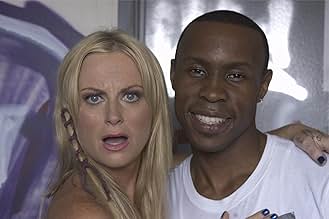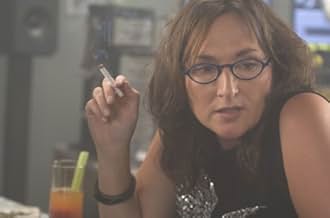Durante uma onda de calor de três dias pouco antes da grande celebração do 4 de julho, uma estrela de ação encontra uma estrela pornô que está desenvolvendo um projeto de reality e um polici... Ler tudoDurante uma onda de calor de três dias pouco antes da grande celebração do 4 de julho, uma estrela de ação encontra uma estrela pornô que está desenvolvendo um projeto de reality e um policial que detém a chave para uma grande conspiração.Durante uma onda de calor de três dias pouco antes da grande celebração do 4 de julho, uma estrela de ação encontra uma estrela pornô que está desenvolvendo um projeto de reality e um policial que detém a chave para uma grande conspiração.
- Direção
- Roteirista
- Artistas
- Prêmios
- 1 vitória e 3 indicações no total
- UPU 4 Officer 3
- (as Chris Ciulla)
Avaliações em destaque
With Southland Tales I was confused a great deal of the time. I was not really able to enjoy the culture bashing due to the really bad dialog and inability to connect many elements of the story. So, if you like bad dialog, poorly developed characters (more like caricatures), a screwed up story that makes no sense without reading the prequel and a badly directed and edited film, watch this, or maybe The Box (another Kelly debacle). Enjoy!
If you are an average viewer, you will be put off by the apparent narrative incoherence, the seeming lack of center and the childish nature of some of the devices. That's all fair enough. But let me point you to two things that make it for me.
The first is that it is inherently cinematic. It makes about as much sense when the sound is turned off. Indeed I watched the whole thing through this way once and it actually makes more sense. There's lots of cinematic nesting: movies about movies; videos, narratives and disguises within. There's lots of causality denoted visually. You will find scores of quotes from other films, many more than those "parody" teen movies. And you'll discover many of your favorite intelligent but not famous actors.
That would be enough for me, but there's something else. In fact, though the story is confusing, deliberately made so through how it unfolds, it does make complete sense. It makes as much sense as, say, "The Matrix." I wish it didn't, but there you are. But its the way the story slips about that is pretty wonderful. You see, a narrative works by the way the pieces connect.
Usually we don't have to work because the way the pieces connect is the way they happen in real life: the causal flow of the narrative telling is the same as in the story. But the detective story, and modern noir changed that and now we have a variety of causal connections that can glue the bits together. Even these you don't normally notice unless the writer as here makes the shifts between bits cover a greater distance than usual.
Pay attention to this. Greenaway uses reference to number sequence. Barney uses progress through the sexual encounter, clever that. Lynch provides these discontinuities by having characters shift selves a technique of discovery. Joyce who in a way is the gold standard because he reified this sort of art through cognitive plumbing connection depends on notational congruence. All these are exciting as getout in the hands of their masters.
But this is different, more rooted in noir, in cinema. These elements are connected in ways that only read in film.
Here's what I mean: film has evolved a set of notions we call noir. These capture two worlds; the world of the story where the laws of the universe seem to be deliberately arranged by strange occurrences, "mistakes" and coincidences to play havoc with key characters. Then there is the (usually implied) second world where those laws are manipulated and we the viewers sit. In almost all noir films, this effect only occurs in the long form, meaning that it is apparent when seem over the whole story.
Now look here. For all intents, there is no long form here, just a sequence of medium- sized events, each of which contain rather than follow the previous ones. This form was pioneered (I believe) by Altman. The narrative glue of the whole is how the segments slip against one another. We have "Magnolia" that plays with this concept as well, this slipperage. Its the connection that conveys the world. Its subtle and homeopathically powerful as a result.
Now this. Its another step forward in that the connection between elements involves changes in the way the world works. Each shift is not just between story segments that don't make sense, they don't make sense BECAUSE of the nature of the transitions. Many of these transitions involve a change in the laws of the universe. Its as if you were playing chess as a chesspiece, and the rules of the game changed according to the patterns of the pieces on the board. The whole thing would make sense afterward when seem as a whole, but the chessmen will be baffled.
What this does is build an ordinary noir with the two worlds: story, and gods. But it cleverly puts the viewer on the chessboard as someone at the mercy of the rules. Its no accident that the inspiration is Philip K Dick (who invented this sort of reverse introspection), that the key magical plot device is the magically named "fluid karma," and that the mascot is Bai Ling, who was our Béatrice Dalle surrogate for a while.
I want to give this a four, but I do think that the two others from this year are more important.
Ted's Evaluation -- 3 of 3: Worth watching.
In the DVD cut of the movie, a lot of things are obscured: what the big picture is, why characters are motivated to do certain things, why multiple identities are a recurring theme, why certain characters/actions are necessary.
What is in the DVD cut is an extensively detailed alternate world. Unfortunately, to make the actions in that alternate world make sense, you basically have to either watch the movie multiple times, or at least know what you're dealing with.
There are at least 4 layers to everything that's going on: 1) political/social commentary on contemporary American society and the apocalyptic undercurrent therein; 2) sarcastic/caustic pop culture references (Philip K. Dick is a big one, but also subtle things... for instance, the Rock was Sean William Scott's protector in "The Rundown" and plays a similar role here); 3) a self-consciousness or self-referentialism: actors cast against type, some similar themes to Donnie Darko, actions that play out in the film are largely based off of the AWFUL screenplay written by one of the characters (as seen in the graphic novel prequels); 4) the actual plot of the movie, which has deep ties to the Book of Revelation, and makes much more sense if the graphic novels are read first.
These layers are pretty consummately intertwined. This is part of what makes this movie to be compelling enough to make me want to put in the necessary effort. Its imagery was provocative, and because Richard Kelly has created such a densely layered world for himself, putting in the time actually is incredibly rewarding.
It should also be said that this film, like Blade Runner or There Will Be Blood, does not let its plot set specifications on its scope, or what it's about. If you hone in on what the director thinks its scope/purpose is, it's much easier to appreciate.
I'm not sure exactly how to rate this movie, since as a stand alone movie it is a failure, but if you take the time to get inside Kelly's mind, it's worthwhile. So. My advice? View it as an investment or don't view it at all. Don't throw it on for an evening's entertainment. If you do, you might be entertained, but you'll probably be confused and angry.
The year is 2008. Justin Timberlake - did I forget to mention him? He plays a drugged-up Iraq war veteran with a huge scar on his face. Who sits in a huge chair with a huge rifle, guarding "Fluid Karma", an ultra-valuable perpetual motion wave machine that is the new form of power since oil has become rare and therefore massively expensive. Politics, anyone? Anyway, JT (who might be telepathic) narrates over an introduction comprised of graphic novel slides and MTV-meets-FOX news bulletins that guides us from our present to the "present" of Kelly's 2008 Southland. The passage of time has not been kind to the US; a nuke has gone off in Texas, and the country has become a police state. The most "recent" clip reveals that Boxer (played by Dwayne Johnson playing The Rock) has disappeared without a trace, which is where the movie begins. Or does it? By this stage, you just might have gotten the impression that Southland Tales is a bit of a mess. And you'd be right. Kelly's attempt at a politically-charged all-encompassing comment on the world that can also appeal to the youth of today does ultimately fall flat, but that's not to say it's without its merits. The satire's often sharp, and the way the movie skips from genre-to-genre (dystopian conspiracy to Scooby Doo farce to musical to action movie) works surprisingly well without jarring too much. The music, while not perfect (I'm pretty sure Black Rebel Motorcycle Club won't have the kind of comeback that allows them to host LA's 4th of July weekend party next year...) creates some of the movie's more memorable moments, such as JT's Killers dance number and the captivating three-way dance toward the end.
The deliberately exaggerated performances are, for the most part, very good, with Johnson capturing the action man (playing an action man - going through a crisis - playing an action man) role very well. The way he switches from the kind of guy who pours beer over himself as a form of refreshment to jittery neurotic mess is both funny and engaging, allowing you to see a little of the man beneath the steely facade.
Unfortunately, this is as close as you'll get to the characters. While the overplaying is amusing, it excludes you on an emotional level. Donnie Darko worked so well because it drew you in, but Southland seems to deliberately keep you at arm's length lest you miss out on some of Kelly's political messages. For all its mystery, intrigue, and action, it feels a bit soulless, and goes out with a whimper as opposed to the bang it so desires.
Southland Tales is an ambitious film, but a messy one, and while it may not work on the kind of level it's aspiring to, in a movie climate where so many films play it safe, at least Kelly tries. Very flawed, but entertaining nonetheless.
Richard Kelly's DONNIE DARKO, while clearly the work of a not-yet-matured filmmaker, gave us the promise of a budding artist whose intentions might have been similar to those aforementioned filmmakers. Unfortunately, after seeing his follow-up, SOUTHLAND TALES, I believe his potential has either been stilted, stalled, or misperceived. In fact, viewing TALES and DARKO back-to-back, his second film comes across as utter regression.
TALES felt like the longest, most expensive student film I've ever seen. At just under three hours, it's a sprawling mess. Oddball for the sake of being oddball, cryptic for the sake of of being cryptic, tonally confused, structurally struggling, I think, no matter how they "clean it up," it will be impossible to salvage.
There's nothing on screen to make you care. To make you invested. There are no stakes. Actually, there's no plot, just a bunch of incidents which are all happening at the same time seemingly to justify why these characters would criss-cross. The characters are so thinly conceived, you find yourself looking at the scenery (all in LA), trying to name the street, beach, or building. The imagery is repetitive and banal. The themes are jumbled and stated over and over again by on-the-nose voice-over from Justin Timberlake.
Watching this was like watching a movie by a severely Autistc filmmaker; in his mind, this all works and has a rhyme and a reason but to me, the viewer, there was absolutely no way to access it. This is not for my lacking of intellectual depth or intelligence. I was awake, aware, acute, and ready to absorb this film. Only, the film wasn't ready to engage me.
Next time at bat, Mr. Kelly should look to the masters he was trying to emulate and see that beneath their audacious sometimes even experimental surfaces, there are real stories and real characters at play.
Você sabia?
- CuriosidadesRichard Kelly consciously sought out actors that he felt had been pigeonholed and wanted to showcase their "undiscovered talents."
- Erros de gravaçãoWhen the home video at the start of the film catches a glimpse of the initial bomb blast, we see the flash and hear the boom at the same instant. Anything close enough to a nuclear blast to hear the boom at the same instant as seeing the flash would be instantly disintegrated.
- Citações
Krysta Now: Scientists are saying the future is going to be far more futuristic than they originally predicted.
- Cenas durante ou pós-créditosAfter the credits, a logo appears of a thumbprint over an American flag with the words: "DON'T TOUCH ME"
- Versões alternativasOriginally running for 160 minutes, Southland Tales premiered at the Cannes Film Festival in 2006 to a disastrous reception. Because of this, it was re-edited and shortened in length as part of the distribution deal. Since the shortened version was shown theatrically and released on DVD, the Cannes cut has been shown on Cable TV and DVD releases in Europe. Some of the changes between the theatrical cut and the Cannes cut are as follows:
- Opens the same as theatrical cut, with home video in Abilene, except with music ('Water Pistol' by Moby) and runs longer. Video is also shown in its original aspect ratio, instead of cropped for 2.35:1.
- Doomsday Scenario Interface is not present in the original cut, it was added to provide background information present in the graphic novels. Instead we have narration from Pilot Abilene explaining the present situation and Treer Corporation.
- The meeting between the Baron and Hideo Takehashi takes place much earlier in the film, Pilot explains the Baron dislikes Takehashi.
- The character of General Teena MacArthur is more fleshed out in original cut, she mainly communicates with General Simon Theory and the Baron.
- Many scenes with dialog between main characters have been extended i.e. scenes with Boxer & Roland, Krysta & Cyndi, Boxer & Starla, Cyndi & Vaughn Smallhouse etc.
- Pilot explains that Bart Bookman is an 'angry man' with a willingness to die.
- Some events that take place are better explained in original cut e.g. Boxer ringing Fortunio before meeting him, Serpentine explaining her actions at the end.
- Features additional effects of the blimp not in theatrical version.
- Features music by Moby not present in theatrical version i.e. 'Ceanograph' is heard in scene giving information on the rift, 'Hotel Intro' is heard as characters visit different sections on the blimp.
- Trilhas sonorasIf I Could Be With You (One Hour Tonight)
Written by Henry Creamer and James P. Johnson (as Jimmy Johnson)
Performed by Louis Armstrong
Courtesy of Columbia Records
By Arrangement with Sony BMG Music Entertainment
Principais escolhas
Detalhes
- Data de lançamento
- Países de origem
- Centrais de atendimento oficiais
- Idioma
- Também conhecido como
- Southland Tales
- Locações de filme
- Empresas de produção
- Consulte mais créditos da empresa na IMDbPro
Bilheteria
- Orçamento
- US$ 17.000.000 (estimativa)
- Faturamento bruto nos EUA e Canadá
- US$ 275.380
- Fim de semana de estreia nos EUA e Canadá
- US$ 117.000
- 18 de nov. de 2007
- Faturamento bruto mundial
- US$ 374.755
- Tempo de duração2 horas 25 minutos
- Cor
- Mixagem de som
- Proporção
- 2.35 : 1
Contribua para esta página





































